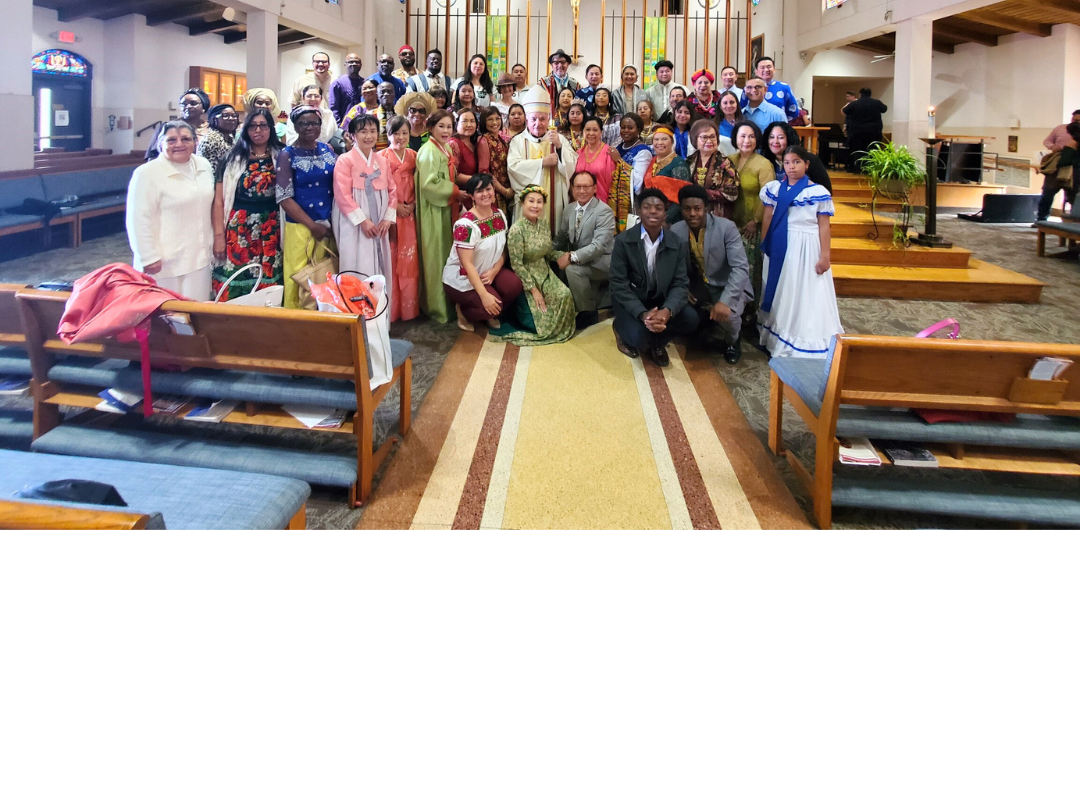On Jan. 27, over 10 ethnic communities within the Diocese of San Bernardino gathered at the Diocesan Migrant Mass to celebrate diversity and through a new, year-long tradition, commit to journeying together in Christ.
“This new tradition is to encourage community building,” said Wilfredo Aguirre, Diocesan Director of Advocacy and Justice for Immigrants. “I really want us to start walking together, respecting the different cultures that we come from but walking as one in Christ.”
The Diocesan Migrant Mass was celebrated by Bishop Emeritus Gerald R. Barnes at Our Lady of the Rosary Cathedral in San Bernardino. This year, the national campaign theme is “Free to choose whether to migrate or to stay.” According to the United States Conference of Catholic Bishops (USCCB), the theme calls attention to the conviction that persons have a right not to migrate and if a person migrates it should be done by choice and not by necessity.
“This community, if we do walk together, then we can celebrate in solidarity,” Aguirre said. “This is an opportunity for us as migrants reflect on the situation of new arrivals and build solidarity through our different groups so that we can welcome those newly arriving.”
The Diocesan Migrant Mass highlights the importance of migration in the world, the U.S. and within the Diocese. Traditionally, the Migrant Mass includes celebration through praying and singing in various languages, showcasing traditional wardrobes and sharing diverse cultural foods. In addition to these traditions, this year’s Migrant Mass debuted a brand-new tradition of presenting, sharing and gifting a patron saint statue from one ethnic community to another.
“This migrant mass is very important, not just because of the robes that we wear, the beautiful costumes, not just because of the different kind of music, but because we're all brothers and sisters that Jesus reminded us in the Gospel,” Bishop Barnes said during the Homily. “Today, we are one family, we are sisters and brothers."
This new tradition called on every ethnic community participating in the Migrant Mass to research and select one saint from their native country that represents and can be a symbol for that community. After choosing their patron saint, each community was asked to obtain a small statue or image of that saint and designate two people that would present it at the Mass.
To begin the Migrant Mass, every ethnic community, dressed in traditional attire, proudly processed in carrying their saint statue/image and placed them by the altar for a special blessing by Bishop Barnes.
However, the new tradition did not conclude with Bishop Barnes’ blessing over the statues, it continued during the reception, with an exchange of culture. At the reception, each ethnic community was asked to present their one-page research on their chosen saint and describe different ways to properly venerate that saint. The presentations wonderfully highlighted each culture’s diverse history, beliefs and customs.
“Our Holy Father is asking us to accept the migrant as a brother and sister in Christ,” Bishop Barnes said. “We are all one family and the great saints that we have as patron saints of our countries. When we listen to their stories and what they had to undergo, we are moved by the sacrifices that they made out of their faith. What sacrifices do we still need to make out of our own faith? And so we celebrate, but we celebrate with a commitment, a commitment to help further the migrants and refugees in our country and in the world.”
After all the presentations were read, each ethnic community took their saint statue/image and gifted it to another ethnic community chosen by the Diocesan Office of Advocacy. The communities were then asked to keep their newly gifted saint statue/image for a whole year until the next January’s Migrant Mass. The communities were also asked to take the statue/image with them throughout the year to different Masses to be blessed, venerated and to spread the word about the meaning of the statue/image.
“This tradition focuses on building relationships with these communities so that we can foster that relationship and move forward into living in solidarity and journeying together in Christ,” Aguirre said.
The tradition will continue next year in a small ceremony prior to the next Migrant Mass, where each ethnic community returns their gifted saint to its original community. Then, each community will prepare to gift their patron saint statue/image to another community at the January Migrant Mass in 2025.
Elena Macias is the Managing Editor of the BYTE.
